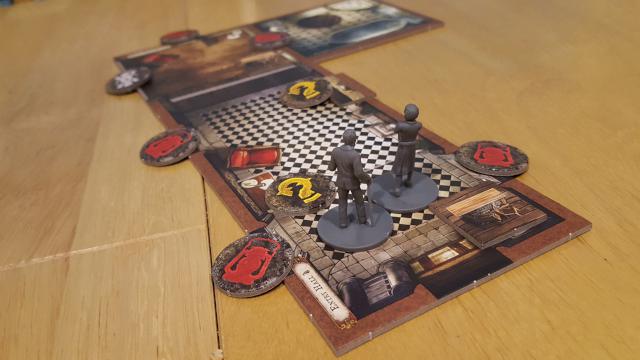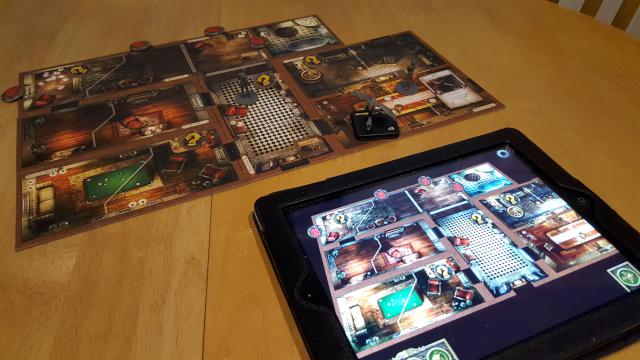
The use of apps within a board game will always be a hotly debated topic among those who play them, and while it’s certainly true that they can get in the way and ruin the gaming experience at times, there are other games which absolutely nail it. Mansions of Madness (or at least this new second edition) fits comfortably in the latter of those categories, bridging the gap between the physical and virtual worlds with a quality which is impossible to miss as soon as you see the box for the first time.
The moment we set eyes on the Mansions of Madness box we knew that the game had potential. It’s a massive box, with great artwork which perfectly sets the tone of the game: a mysterious, old and slightly scary looking mansion ready to be explored by anyone brave enough. Inside the box itself was loads of stuff to sort out before playing – dozens of tokens for searching, exploring and barricading. Character tokens, enemy cards, extra bits of wall, decor and furniture, and the location tiles themselves all need popping out and organising, something made slightly trickier by the lack of compartments or bags included in the box – we ended up using sandwich bags to store the tokens between games to save the hefty effort of sorting things that have been rattling around loose in the box. Slightly annoying, and entirely avoidable by including some bags in the box, but not really the end of the world.

Also present are the character and enemy components too, with the enemy models needing to be clipped onto a plastic support to help them stand up. The models look good, but aren’t quite up to those provided by the likes of Cool Mini or Not, and are a bit of a pig to clip onto the stands. It’s all stuff you’ll only need to do once though, and goes some way to explaining why the box is so big with so much empty space when you first open it: you’re not going to want to take these things apart every time you stop playing.
But these are just little gripes with some bits of plastic. With the setup done, the numerous parts organised and the game ready to play it’s about time to find just what makes Mansions of Madness so special, and boy oh boy is it special. The key lies in the fact that the app keeps track of the mansion itself, but not the game. The app doesn’t care where the characters are, it doesn’t care about what items your character has, nor where exactly the enemy creatures have got themselves too. Instead it deals with the story telling aspect, telling you what you found as a result of searching that bookcase, which area you’ve just discovered by opening that door in the corner, and which enemy has just jumped out at you because you were stupid enough to follow a disturbing noise. You as gamers play the game, the app just tells the story. It’s a fantastic way to use a digital addition to the game, giving you the mystery of not knowing what’s round the corner, not even knowing what’s on the other side of the door, right up until the moment you open it. Searching areas is an uncertain affair too, often resulting in a skill test (dice rolls, generally) which impact just how useful your search ends up being, with the results of that again being led by the app – you won’t know what else you might’ve found with other results, just like you wouldn’t know if you’d have found something else in real life had you spent a few more moments looking.

So what of the name? Where’s the madness? That comes, trust me. As more monsters enter the mansion, the chances of your character going mad increases, to the point where you may well end up insane. In such an instance the player reads their insane card which will affect how they play, but keeps it to themselves. At this point several games came to mind – there’s the insanity and altered mechanics from Pandemic Cthulhu, but the secretive nature of Dead of Winter. That’s no bad thing, those two elements were things I really enjoyed about those games, so to bring them together into one insane pot here works very well. But going insane changes how your team of investigators wins the game; it may be that you start to find fire more comforting, so you just need to start lighting as many fires in the mansion as possible – once you hit a certain number of fires everyone wins, no matter what else is going on. On the flip side, if the game ends for any other reason, be it another insane player’s condition or you solve the mystery, then everyone loses. They won’t know they’ve lost until they appear to win and you chirp up with “yeah, about that…”, but that’s part of the beauty of going insane.
Another issue with that is that for much of the game you don’t fully know what you’re trying to achieve. That’s good, far far better than it sounds, because you enter this house not knowing what you’ve stumbled upon. As the game progresses, as you search for things and find information, and the app adapts the outcome as you play. Take too long, and the end goal becomes harder, up to the point of practically impossible. You’re never aware of what time you’ve got left, or when the app will turn up that crucial piece of information, but that’s all the fun of being an investigator, and it’s reflected superbly in the game.

There’s a fair bit more to Mansion of Madness than this, and I could go on for ages about the things I liked, but that would take the edge off discovering them for yourself. The magic is in the mystery, and whether you’re playing alone or with others there’s a great experience to be had here. I’m really hoping to see the app updated with new scenarios, mansion layouts and so on because in theory this could be endless in terms of possibilities, but that’s yet to be seen. There’s a hefty price tag attached to this, but if you can spare the cash and want something which will make you look at the possibilities of board games in a whole new light then you should grab it and run.
Mansions of Madness
Available Now, RRP £92.99
Find your local stockist here

Leave a Reply